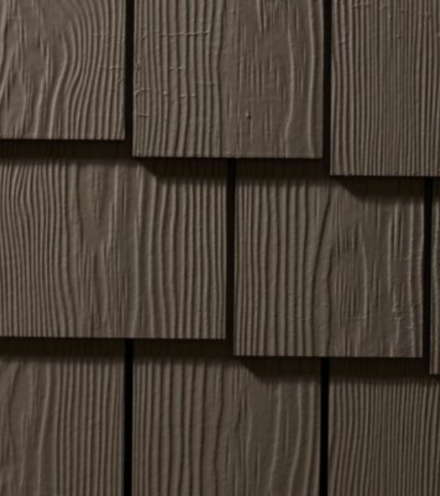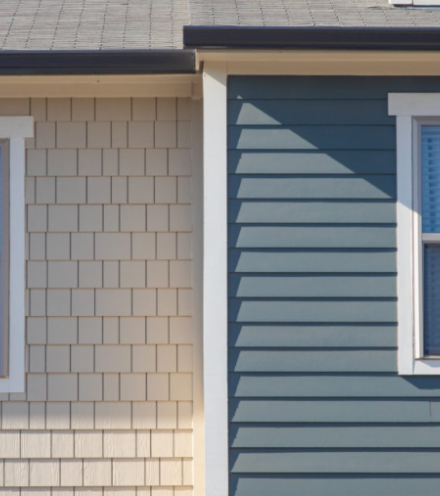Materials make a big difference when it comes to building an eco-friendly home. There are many factors used to assess how sustainable a particular material is. When it comes to siding, fiber cement is the best option for building a green home because it combines energy efficiency with noticeable compositional advantages, like durability and longevity – all without sacrificing aesthetics.
Take a look at how other materials, like wood and vinyl, match up against fiber cement and what elements to look for when determining how eco-friendly a particular product is.
Most Important Elements of Green Homes

There are a number of different elements to look for when trying to decide how green a product is. These same guidelines can be applied to any aspect of building or remodeling a home. For the purposes of this article, we’ll consider specifically how these eco-friendly benchmarks come into play when shopping for exterior house siding.
Energy Efficiency
Energy efficiency refers to the amount of energy needed to operate everyday household needs, including heating, cooling, lighting, running appliances, and using electronics within the home. The less energy expended, the more energy efficient the home is said to be.
Siding plays a role in energy efficiency because it affects heating and cooling. Siding materials that are more energy efficient tend to maintain indoor temperature easier, meaning the A/C or HVAC unit is running less. Certain materials conduct heat at a faster rate, meaning the material choice of siding can ultimately impact the home’s energy efficiency.
Healthy Surroundings
Green homes are also constructed using materials that are considered safer overall – for people and the environment. This factors in things like indoor air quality, PFAS, and chemicals used for finishes and stains.
Environmentally Responsible
It seems like a no-brainer, but building materials don’t originate at the home improvement store. Everything must be sourced from somewhere, which affects the environment in one way or another. Green homes tend to feature products that have been manufactured or harvested in accordance with environmentally responsible practices.
Long-Lasting Durability
Finally, the longevity component impacts sustainability because the less often you have to replace or repair something, the less material waste accrues. Siding that is easily scratched, dented, buckled, or rotten must be replaced, meaning more materials are needed to maintain the home. Durability has a direct impact on the longevity and lifespan of siding, so more durable siding materials are preferred for green homes.
Fiber Cement is a Better Choice Than Vinyl or Wood

When you compare these basic building blocks of green homes to the different siding materials on the market, it’s easy to see why fiber cement is the preferred choice. Outperforming vinyl and wood in every principle of eco-friendly craftsmanship, fiber cement siding is the way to go.
While wood is a biodegradable option – generally a good quality when assessing sustainability – it must be harvested responsibly, which is often hard to verify when shopping for wood siding. When harvested irresponsibly, wood products can contribute to deforestation, which ultimately impacts global warming, soil erosion, and habitat loss for native plants and animals. Wood is also very susceptible to damage and has a considerably short lifespan, making it a poor choice for green buildings.
Vinyl, the other common siding option, also ranks poorly for durability and product lifespan. People mistakenly believe that vinyl siding is eco-friendly because it’s recyclable. This doesn’t tell the whole story. Vinyl siding features polyvinyl chloride (PVC), so finding a recycling center that actually accepts it is difficult – and costly. For this reason, most vinyl siding ends up in the landfill, or burned, which releases additional greenhouse gasses and toxins. Even the production of vinyl siding itself results in the release of nitrogen oxide, known carcinogens like dioxin, and sulfur dioxide, which is linked with acid rain and smog.
When compared with vinyl and wood siding, fiber cement is clearly the more sustainable option. It ranks much higher on the essential elements of sustainability, including durability, energy efficiency, longevity, and composition. Built to be water resistant, virtually fireproof, and a tough defense against insect damage, fiber cement siding offers the long-lasting protection needed to avoid frequent replacement.
Allura Specializes in Fiber Cement Siding for Green Homes

Allura prides itself in providing a smart, modern, eco-friendly option for house siding.
Confident in the longevity of their fiber cement siding options, Allura offers a 50-year warranty. Allura is also a member of the U.S. Green Building Council and National Association of Homebuilders. They’ve done the work needed to achieve these important certifications, and Allura fiber cement products are also designed with LEED considerations in mind.
In addition to producing a reliable product that’s perfect for building a green home, Allura fiber cement siding is absolutely beautiful, too. With a wide spectrum of colors to choose from, it’s easy to find the perfect tone that matches your creative tastes. Plus, exciting design options – like lap, wood grain textures, smooth panel and shake – give homeowners the room to get creative and design a home that really stands out.
Ready to build a green home with amazing curb appeal? Contact Allura today to explore a plethora of fiber cement siding options that you’ll love!




